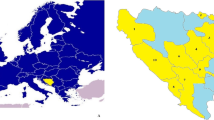Abstract
Aim
Human trichinellosis is an important food-borne zoonotic disease that causes financial losses and health problems for the population. Sporadic cases and outbreaks of different intensities are recorded each year in Bulgaria. With this work we attempt to clarify the main reasons leading to outbreaks of trichinellosis in the country and to compare the recorded incidence with that in other European countries.
Subjects and methods
In the present study, the epidemiological, clinical, and laboratory data of the trichinellosis outbreaks recorded in the country from 2008 to 2014 were analyzed. Epidemiological data based on a standard protocol with full case descriptions were collected for each region of the country and analyzed at the National Center of Infectious and Parasitic Diseases in Sofia.
Results
Between 2008 and 2014, 29 outbreaks were recorded in Bugaria. Of 1670 people who consumed meat or meat products contaminated with Trichinella larvae, 710 were infected. The annual incidence of human trichinellosis for the period varied from 0.22 to 5.82 per 100,000 population. Studies using the polymerase chain reaction technique identified Trichinella spiralis and Trichinella britovi as the causative agents of trichinellosis among humans in Bulgaria.
Conclusions
Of all food-borne parasitic diseases, trichinellosis has the most pronounced negative effect on human health in the Republic of Bulgaria, and the country is still one of the European Union member states with a high human morbidity rate from trichinellosis.


Similar content being viewed by others
References
Akkoc N, Kuruuzum Z, Akar S, Yuce A, Onen F, Yapar N, Ozgenc O, Turk M, Ozdemir D, Avci M, Guruz Y, Oral AM, Pozio E (2009) A large-scale outbreak of trichinellosis caused by Trichinella britovi in Turkey. Zoonoses Public Health 56(2):65–70. doi:10.1111/j.1863-2378.2008.01158.x
Boutsini S, Papatsiros VG, Stoigiou D, Marucci G, Liandris E, Athanasiou LV, Papadoudis A, Karagiozopoulos E, Bisias E, Pozio E (2014) Emerging Trichinella britovi infections in free ranging pigs of Greece. Vet Parasitol 199:278–282. doi:10.1016/j.vetpar.2013.10.007
Capo V, Despommier DD (1996) Clinical aspects if infection with Trichinella spp. Clin Microbiol Rev 9(1):47–54
Commission Regulation (EC) No 2075/2005 of 5 December 2005 laying down specific rules on official controls for Trichinella in meat. Official Journal of the European Union 22.12.2005. http://eur-lex.europa.eu/legal-content/EN/ALL/?uri=CELEX%3A32005R2075. Accessed 19 Sept 2014
Cuperlovic K, Djordjevic M, Pavlovic S (2005) Re-emergence of trichinellosis in southeastern Europe due to political and economic changes. Vet Parasitol 132:159–166
Digital Library of National Statistical Institute. Population of Bulgaria by years. http://statlib.nsi.bg:8181/isisbgstat/SSP/isisframes-basic.html. Accessed 30 Sept 2014
Directive 2003/99/EC of the European Parliament and of the Council of 17 November 2003 on the monitoring of zoonoses and zoonotic agents Official Journal of the European Union 2003: 325–331
Dupouy-Camet J (2006) Trichinellosis: still a concern for Europe. Euro Surveill 11(1):5
Dupouy-Camet J, Bruschi F (2007) Management and diagnosis of human trichinellosis. In: Dupouy-Camet J, Murrell KD (eds) FAO/WHO/OIE guidelines for the surveillance, management prevention and control of trichinellosis. World Organisation for Animal Health Press, Paris, pp 37–68
Genov G, Boeva V (1990) Achievements and prospects of the fight against helminth infection in Bulgaria. Med Parasitol Parasit Dis 3:23–26 (in Russian)
Gottstein B, Pozio E, Nockler K (2009) Epidemiology, treatment and control of Trichinellosis. Clin Microbiol Rev 22(1):127–145. doi:10.1128/CMR.00026-08
Ivanova M, Kurdova R (2008) Trichinellosis. In: Kurdova R (ed) Parasitic zoonozes in humans. Publ. NCIPD, Sofia, pp 50–87 (in Bulgarian)
Kurdova R, Muller N, Tsvetkova N, Michov L, Georgieva D, Ivanova M, Gottstein B (2004) Characterization of Trichinella isolates from Bulgaria by molecular typing and cross-breading. Vet Parasitol 123(3-4):179–188
Kurdova-Mintcheva R, Jordanova D, Ivanova M (2009) Human trichinellosis in Bulgaria—epidemiological situation and trends. Vet Parasitol 159(3-4):316–319. doi:10.1016/j.vetpar.2008.10.070
Ministry of Agriculture and Food. Regulation no 110/18.09.2006 Requirements for specific performance of official controls for Trichinella in meat. State Gazette, 83 (in Bulgarian)
Ministry of Health. Ordinance no 21/08.07.2011 for the registration, notification and reporting of communicable diseases. State Gazette 52, 29-61. http://www.mh.government.bg/Regulations. Accessed 02 June 2014
Ministry of Health. Ordinance no 5/06.04.2006 on the diagnosis, prevention and control of local parasitic diseases. State Gazette 40, 83–90 (in Bulgarian)
Murrell KD, Pozio E (2011) Worldwide occurrence and impact of human trichinellosis, 1986–2009. Emerg Infect Dis 17(12):2194–2202. doi:10.3201/eid1712.110896
Neghina R, Neghina AM, Marincu I (2012) Trichinellosis in hospitalized patients from a Romanian endemic area, 2007–2009. Clin Microbiol Infect 18:86–90. doi:10.1111/j.1469-0691.2011.03573.x
Pozio E, Zarlenga DS (2013) New pieces of the Trichinella puzzle. Int J Parasitol 43(12-13):983–997. doi:10.1016/j.ijpara.2013.05.010
Pozio E, Hoberg E, La Rosa G, Zarlenga DS (2009) Molecular taxonomy, phylogeny and biogeography of nematodes belonging to the Trichinella genus. Infect Genet Evol 9(4):606–616. doi:10.1016/j.meegid.2009.03.003
Sadkovska-Todys M, Golab E (2012) Trichinellosis in Poland in 2010. Przegl Epidemiol 66(2):307–310 (in Polish)
Sadkovska-Todys M, Golab E (2013) Trichinellosis in Poland in 2011. Przegl Epidemiol 67(2):259–261
World Health Organisation, Regional Office for Europe. http://data.euro.who.int/CISID/. Accessed 03 May 2014
Zarlenga DSM, Chute B, Martin A, Kapel CMO (1999) A multiplex PCR for unequivocal differentiation of all encapsulated and non-encapsulated genotypes of Trichinella. Int J Parasitol 29:1859–1867
Author information
Authors and Affiliations
Corresponding author
Ethics declarations
Conflict of interest
The authors declare that they have no conflict of interest.
Funding
None.
Rights and permissions
About this article
Cite this article
Rainova, I., Kaftandjiev, I., Harizanov, R. et al. Outbreaks of human trichinellosis, still a challenge for the public health authorities in Bulgaria. J Public Health 24, 291–297 (2016). https://doi.org/10.1007/s10389-016-0724-9
Received:
Accepted:
Published:
Issue Date:
DOI: https://doi.org/10.1007/s10389-016-0724-9




